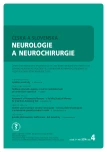Limits of Verbal Fluency Tests Use in the Differential Diagnostic of Neurological Diseases
Authors:
Z. Hummelová 1,2; E. Janoušová 3
Authors‘ workplace:
I. neurologická klinika LF MU a FN u sv. Anny v Brně
1; Ústav ochrany a podpory zdraví, MU, Brno
2; Institut biostatistiky a analýz, MU, Brno
3
Published in:
Cesk Slov Neurol N 2014; 77/110(4): 487-492
Category:
Short Communication
Overview
Verbal fluency tests are simple assessments evaluating patients’ mental flexibility, ability to organize information into semantically similar groups, effective recall strategies and quality of working memory. Based on the results of research into brain imaging and functional brain imaging methods, experts assume that, while frontal lobe lesions are linked to rather inconsistent performance patterns in phonemic verbal fluency, temporal lobe lesions are more related to deficits in semantic verbal fluency. The aim of our study was to verify validity of these findings in routine clinical psychological practice during differential diagnostic procedure in the area of specific neurological disorders. Four groups of patients were included in the study: patients with frontal lobe epilepsy, two groups of patients with temporal lobe epilepsy – left and right hemisphere, and patients with Parkinson’s disease. Each group consisted of 25 patients. Statistical analysis was performed using the nonparametric Kruskal-Wallis test. The results showed no statistically significant differences in the scores of semantic and phonemic verbal fluency between the groups.
Key words:
semantic verbal fluency – phonemic verbal fluency – epilepsy – Parkinson’s disease
Sources
1. Tombaugh TN, Kozak J, Rees L. Normative data stratified by age and education for two Measures of verbal fluency: FAS and animal naming. Arch Clin Neuropsychol 1999; 14(2): 167– 177.
2. Harrison JE, Buxton P, Husain M, Wise R. Short test of semantic and phonological fluency: normal performance, validity and test‑ retest reliability. Br J Clin Psychol 2000; 39(2): 181– 191.
3. Spreen O, Strauss E. Controlled Oral Word Association (COWA). In: A Compendium of Neuropsychological Tests. Administration, Norms, and Commentary. 2nd ed. New York, Oxford: Oxford University Press 1998: 447– 464.
4. Preiss M, Kalivodová Z, Kundrátová I, Mrlinová L, Ježková T, Kubů M et al. Test verbální fluence – vodítka pro všeobecnou dospělou populaci. Psychiatrie 2002; 6(2): 74– 77.
5. Preiss M, Rodriguez M, Kawaciuková R, Laing H. Verbální fluence. In: Neuropsychologická baterie Psychiatrického centra Praha. 2. přepracované vydání. Praha: Psychiatrické centrum Praha 2007: 37– 40.
6. Preiss M, Kučerová H et al. Verbální fluence. In: Neuropsychologie v psychiatrii. Praha: Grada Publishing 2006: 389– 392.
7. Ross TP, Calhoun E, Cox T, Wenner C, Kono W, Pleasant M. The reliability and validity of qualitative scores for the Controlled Oral Word Association Test. Arch Clin Neuropsychol 2007; 22(4): 475– 488.
8. Henry JD, Crawford JR. Verbal fluency deficits in Parkinson’s disease: a meta-analysis. J Int Neuropsychol Soc 2004; 10(4): 608– 622.
9. Troyer AK, Moscowitch M, Winocur G, Alexander MP,Stuss D. Clustering and switching on verbal fluency: the effects of focal frontal‑ and temporal‑ lobe lesions. Neuropsychologia 1998; 36(6): 499– 504.
10. Lezak MD, Howieson DB, Loring DW. Verbal functions and language skills. In: Neuropsychological assessment. 4th ed. Oxford: Oxford University Press 2004: 501– 530.
11. Laisney M, Matuszewski V, Mézenge F, Belliard S,de la Sayette V, Eustache F et al. The underlying mechanisms of verbal fluency deficit in frontotemporal dementia and semantic dementia. J Neurol 2009; 256(7): 1083– 1094. doi: 10.1007/ s00415‑ 009‑ 5073‑ y.
12. Schönknecht ODP, Toro P, Hunt A, Henze M, Haberkorn U, Schröder J. Neural correlates of cognition deficits in mild cognitive impairment and Alzheimer’s disease. Mind and Brain 2011; 2(1): 1– 8.
13. Sarkis RA, Busch RM, Floden D, Chapin JS, Kenney CK, Jehi L et al. Predictors of decline in verbal fluency after frontal lobe epilepsy surgery. Epilepsy Behav 2013; 27(2): 326– 329. doi: 10.1016/ j.yebeh.2013.02.015.
14. Birn RM, Kenworthy L, Case L, Caravella R, Jones TB,Bandettini PA et al. Neural systems supporting lexical search guided by letter and semantic category cues: a self‑ paced overt response fMRI study of verbal fluency. Neuroimage 2010; 49(1): 1099– 1107. doi: 10.1016/ j.neuroimage.2009.07.036.
15. Nagels A, Kircher T, Dietsche B, Backes H, Marquetand J, Krug A. Neural processing of overt word generation in healthy individuals: the effect of age and word knowledge. Neuroimage 2012; 61(4): 832– 840. doi: 10.1016/ j.neuroimage.2012.04.019.
16. Heinzel S, Metzger FG, Ehlis A, Korell R, Alboji A,Haeussinger FB et al. Aging‑related cortical reorganization of verbal fluency processing: a functional near‑ infrated spectroscopy study. Neurobiol Aging 2013; 34(2): 439– 450. doi: 10.1016/ j.neurobiolaging.2012.05.021.
17. Tupak SV, Badewien M, Dresler T, Hahn T, Ernst LH,Herrmann MJ et al. Differential prefrontal and frontotemporal oxygenation patterns during phonemic and semantic verbal fluency. Neuropsychologia 2012; 50(7): 1565– 1569. doi: 10.1016/ j.neuropsychologia.2012.03.009.
Labels
Paediatric neurology Neurosurgery NeurologyArticle was published in
Czech and Slovak Neurology and Neurosurgery

2014 Issue 4
Most read in this issue
- Sensory Examination
- Genetic Variability in Attention Deficit Hyperactivity Disorder
- Spinal Arteriovenous Malformations – Two Case Reports
- The Value of Repeated Non-confirmatory Multiple Sleep Latency Test (MSLT) for the Diagnosis of Narcolepsy
